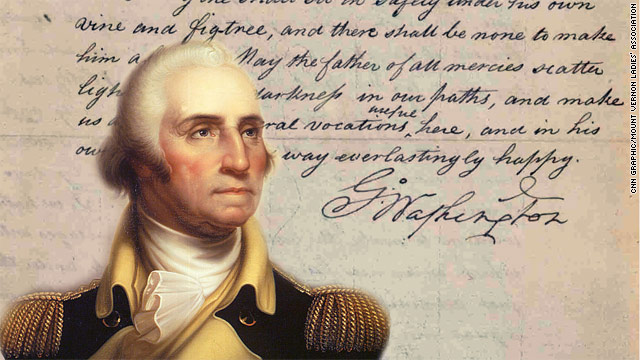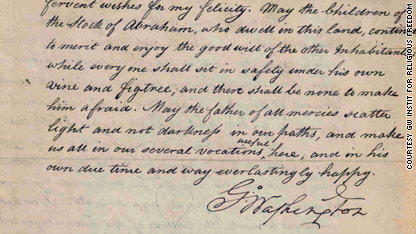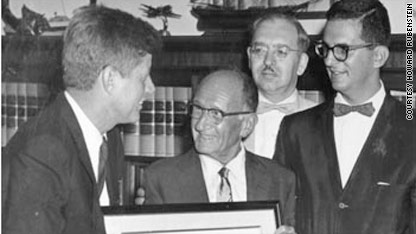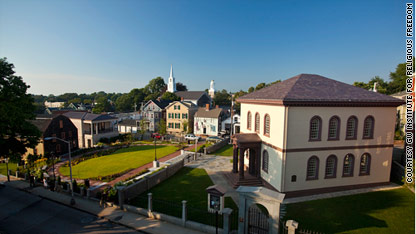
After decade in storage, Washington letter on religious freedom will go public
Washington (CNN) – After sitting in storage for nearly a decade, George Washington’s signature statement on religious liberty will go on display this summer in the city where freedom of religion was enshrined in the Constitution: Philadelphia.
America’s first president wrote the letter to a Jewish congregation in Newport, Rhode Island, in 1790, assuring American Jews that their freedom of religion would be protected. The document will go on display this summer for the first time since 2002 in an exhibition at Philadelphia’s National Museum of American Jewish History.
For nine years, the letter has been kept out of public view, in storage at a sterile Maryland office park a few hundred feet from FedEx Field, where the Washington Redskins play. CNN took an inside look at the document in September.
But the Morris Morgenstern Foundation, which owns the letter, has agreed to put the historic document on public display, officials at the National Museum of American Jewish History said.
“Our institution as well as others have been trying to have access to (this) for a long time,” said museum director and CEO Ivy Barsky. “We feel fortunate that the Morgenstern Foundation thought us worthy.”
The loan agreement between the museum and the foundation is unusual. The museum will have the letter for three years but will be allowed to show it for just three months per year. The letter will be kept in a dark storage area for preservation for the other nine months.

An excerpt of the letter showing George Washington's signature.
The document will be accompanied by an exhibit called “To Bigotry No Sanction: George Washington and Religious Freedom,” which will run June 29 to September 30. Barsky said the exhibit came together only after the museum was certain it could showcase Washington’s letter.
Before going into storage in 2002, the letter was on display at the Klutznick Museum at B’nai B’rith International Headquarters in Washington. It was on display there for 45 years before the organization downsized, closing its museum. The letter went into storage.
After that, many people did not realize where the letter had gone, according to Jane Eisner, editor of Forward, a Jewish newspaper. Eisner dedicated a series of editorials over the last year to lobbying for public display of the letter. She also sent a reporter, Paul Berger, to research the history of the letter.
“This is one of those rare moments as a journalist where you can see the fruits of your labor,” Eisner said. “All we had was all Washington had, which was words. We just have our words and arguments that we try to put out in the public sphere as best we could.”

Morris Morgenstern, center, showed a number of notable people his prized letter, including then-Sen. John F. Kennedy.
The letter is considered to be Washington’s key public statement on religious freedom. Eisner and Barsky say that the document signaled a welcoming of all people to America in pursuit of freedom.
“May the father of all mercies scatter light, and not darkness, upon our paths,” the letter reads, “and make us all in our several vocations useful here, and in His own due time and way everlastingly happy.”
The letter addressed the congregation’s fears that Jews could face discrimination in the new nation. “The letter starts off to the Hebrew congregation of Newport, Rhode Island,” said Mordechai Eskovitz, rabbi of the Touro Synagogue in Newport. “It was meant for the congregation. It is addressed to the congregation.”

The Touro Synagogue, in Newport, Rhode Island, where Washington sent his letter.
The Library of Congress had asked to display the letter during a 2004 exhibit on the 350th anniversary of Jewish life in America. When the loan was not completed, many historians speculated that no one would be able to meet the standards of the Morgenstern Foundation for exhibiting the letter.
“Usually people would die just to be invited to display their property,” said Jonathan Sarna, professor at Brandeis University and a pre-eminent scholar on Jewish-American history. “If the Library of Congress wanted something of mine, they would have it the next day with insured mail.”
Berger, the Forward reporter, says the letter’s placement at another Jewish museum could mean the Morgenstern family would like to see the letter stay in a Jewish facility. “Nobody knows why the family chose the museum in Philadelphia over the Library of Congress,” he said.
The Morgenstern Foundation did not respond to requests for comment.
It is unclear where the document will go after its three-year loan at the Museum of American Jewish History.
– CNN’s Dan Merica contributed to this report.
SOURCE: http://religion.blogs.cnn.com/
Leave a comment and / or appreciate the article!
CLICK HERE to read more:» http://www.radio-elshaday.de/
CLICK HERE to read more:» http://www.radio-megapower.de/
CLICK HERE to read more:» http://christliche-radiosender.blogspot.com/
CLICK HERE to read more:» http://radiomegapower-nonstop.blogspot.de/
Posted by: Daniel Ioan Notar *DJ_DANY*
Keine Kommentare:
Kommentar veröffentlichen